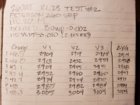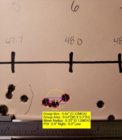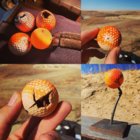Fast14riot
Gold $$ Contributor
Following a post @JLT made a while back experimenting with RL23 in his 260AI I decided it would be a good powder for me to try. I picked up a keg and initially did not have good luck with it using Lapua brass and 140RDF. H4831 shot much better for me. Well, after losing primer pockets in the Lapua brass after 5-6 firings and running a compressed load with the 140RDF, I was almost out of H4831 and the 140RDF. So, I bought some Peterson SRP brass. Ran my current load through it for fire forming and a couple of matches, now to test the RL23 again. I was also switching from the RDF to the Berger 140VLD Target. Here are my results from today...
Berger 140VLD Target and RL23 load testing.
Atmospherics: Linden Range, Linden, CA
ASL ~100' 73°F, 29.9in/Hg
Wind 0-3, swirling
Rifle:
Rem700SA
CBI Remage, 260AI Match chamber
Jewell trigger
Sightron SIII 8-32x56
Rem 40xb stock (no pillars or bedding)
Cowan front rest, Protektor rear bag
Shot from bench, 200 yards.
Velocities collected by MagnetoSpeed Sporter
Load:
Peterson SRP 260 brass. Fired 2x, not annealed Shoulder bump 0.002"
RL23
Berger 140VLD Target, not sorted
Federal 205M
2.325" BTO (-0.010")
Test procedure:
3 strings from 46.5gr through 48.3gr in 0.3gr steps. Groups fired round robin, i.e. string 1, charges 1-7, string 2, charges 1-7, string 3, charges 1-7. This eliminates firing that tiny group in a favorable condition but may not actually be a good node.
Looking at the entire target, it is clear to me that this powder likes to live in the upper half of acceptable pressure levels before velocities stabilized. I had already determined this bullet likes a jump of 0.010" with a previous load using H4831, so all rounds were loaded to current throat dimension.
Based on these results I will load charges between #5 and #6, as there is only an 11fps difference between them and vertical dispersion of each group as a whole was minimal. I do not calculate SD for 3 round groups as it is statistically insignificant, so averages are best for small sample sizes, but I do take into account ES.
If you cannot see the pictures with the velocities, let me know and I will type them out as well.




Berger 140VLD Target and RL23 load testing.
Atmospherics: Linden Range, Linden, CA
ASL ~100' 73°F, 29.9in/Hg
Wind 0-3, swirling
Rifle:
Rem700SA
CBI Remage, 260AI Match chamber
Jewell trigger
Sightron SIII 8-32x56
Rem 40xb stock (no pillars or bedding)
Cowan front rest, Protektor rear bag
Shot from bench, 200 yards.
Velocities collected by MagnetoSpeed Sporter
Load:
Peterson SRP 260 brass. Fired 2x, not annealed Shoulder bump 0.002"
RL23
Berger 140VLD Target, not sorted
Federal 205M
2.325" BTO (-0.010")
Test procedure:
3 strings from 46.5gr through 48.3gr in 0.3gr steps. Groups fired round robin, i.e. string 1, charges 1-7, string 2, charges 1-7, string 3, charges 1-7. This eliminates firing that tiny group in a favorable condition but may not actually be a good node.
Looking at the entire target, it is clear to me that this powder likes to live in the upper half of acceptable pressure levels before velocities stabilized. I had already determined this bullet likes a jump of 0.010" with a previous load using H4831, so all rounds were loaded to current throat dimension.
Based on these results I will load charges between #5 and #6, as there is only an 11fps difference between them and vertical dispersion of each group as a whole was minimal. I do not calculate SD for 3 round groups as it is statistically insignificant, so averages are best for small sample sizes, but I do take into account ES.
If you cannot see the pictures with the velocities, let me know and I will type them out as well.

















